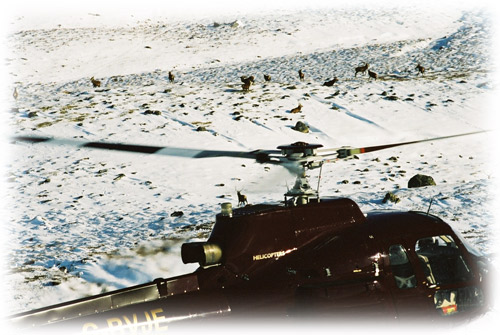Aim
The aim of this guide is to provide guidance on safeguarding welfare when helicopters are used in the presence of deer. In developing the guidance, DCS and veterinary professionals have considered, for comparative purposes, how deer behave when moved by other vehicles, by people on foot or with dogs, or as a result of management activities such as intensive culling. Existing guidance prepared for the agricultural sector and aimed at protecting the welfare of livestock where they are moved for management purposes has also been taken into account.

Setting the context
Helicopters are used in deer management activities for logistical support , deer census and moving deer from or to specific areas. They are also used for filming deer for documentary, promotional or research purposes.
It is imperative that the welfare of deer is safeguarded to the same extent as it is when other deer management activities are undertaken.
Guidelines
Those involved in helicopter operations should be fully aware of the effects of helicopters on deer.
- All personnel should monitor and respond to the signs and conditions in the table below.
| General Behaviour: | Deer are alert to visual, sound, and scent stimuli | Deer reacting to presence of helicopter | Deer fleeing in uncontrolled manner |
| Signs to observe: | Deer: •Should behave and interact normally with others in the herd •React to visual, sound or scent stimuli •Show controlled movement •May run •May stand | Deer: •May be in poor condition •May be on rough/steep terrain •May run at speed •May have mouths open or tongues hanging out •Stragglers may be left behind | Deer: •Are falling •Are stumbling •Are injured •Not adhering to herd hierarchy nor dynamics •No longer reacting to visual, sound ...etc ( in effect ‘at bay’) |
| Action: | Unlikely to be causing distress | Continue with caution or withdraw (potential for welfare issue) | Withdraw |
In addition, all personnel should comply with the following guidelines in order to avoid causing unnecessary suffering:
- Ensure movement of calf/hind groups by helicopter is minimised between May-Sept except in exceptional circumstances, for example in the interests of public safety.
- When requiring to move deer, provide the minimum of pressure required to cause deer to move off or change direction.
- Ensure that all personnel on board the helicopter constantly monitor the herd for early signs of distress.
- Withdraw the helicopter from the vicinity if the herd begins to fragment (where it is no longer a cohesive unit and groups or individuals begin to separate).
- Withdraw where deer continually resist attempts to change their direction.
- Try to move deer away from fence lines. Where deer must negotiate fences, if possible open gates in advance, or drop sections of the fence. Where deer have to jump the fence allow them to do so calmly.
- Do not move herds of deer with juveniles younger than 4 months across fences.
Particular attention should be taken to ensure that the combination of the helicopter and the topography does not pose an additional welfare risk e.g. in steep or rocky areas. Personnel using helicopters should be fully aware of and able to identify welfare issues and implement SNH guide Driving Deer: Code of Conduct as well as elements of the BPG Welfare: Culling guide with respect to practical welfare assessment.
Preventing unnecessary suffering remains the primary concern. The purpose for which the deer are being moved is therefore crucial in deciding whether the activity should take place.
Moving deer for the purpose of filming only for example, is unlikely to be justifiable when signs and conditions fall within the amber zone.
Where deer are to be moved for deer management or control objectives, operators should be committed to completing the operation, provided the signs remain within the green and amber zones and where there would be a greater overall welfare cost in undertaking the task on another occasion.
Moving deer and the law
It is legal for:
Anyone to use a helicopter to move deer where they do not have the intention to take, or wilfully kill, or injure the deer1. For example, deer can be moved in order to count them, clear them from an area where they are causing damage or pose a threat to safety.
Any person holding the legal right to take deer may, use a helicopter to move deer with the intention to take only, provided they do not cause unnecessary suffering [Section 41(2) of the Act2].
It is illegal to:
Use a helicopter to move deer with the intention of killing them [Section 19 (1) of the Act2].
However Scottish Natural Heritage may under certain specific conditions drive deer with the intention to kill [Section 14 of the Act2].
1.“Drive deer with the intention to take” means to intentionally as part of a planned operation move deer to the capture enclosure being used to take. “Drive deer with the intention to kill” means to intentionally as part of a planned operation move deer to waiting rifles.
2. The Deer (Scotland) Act 1996
